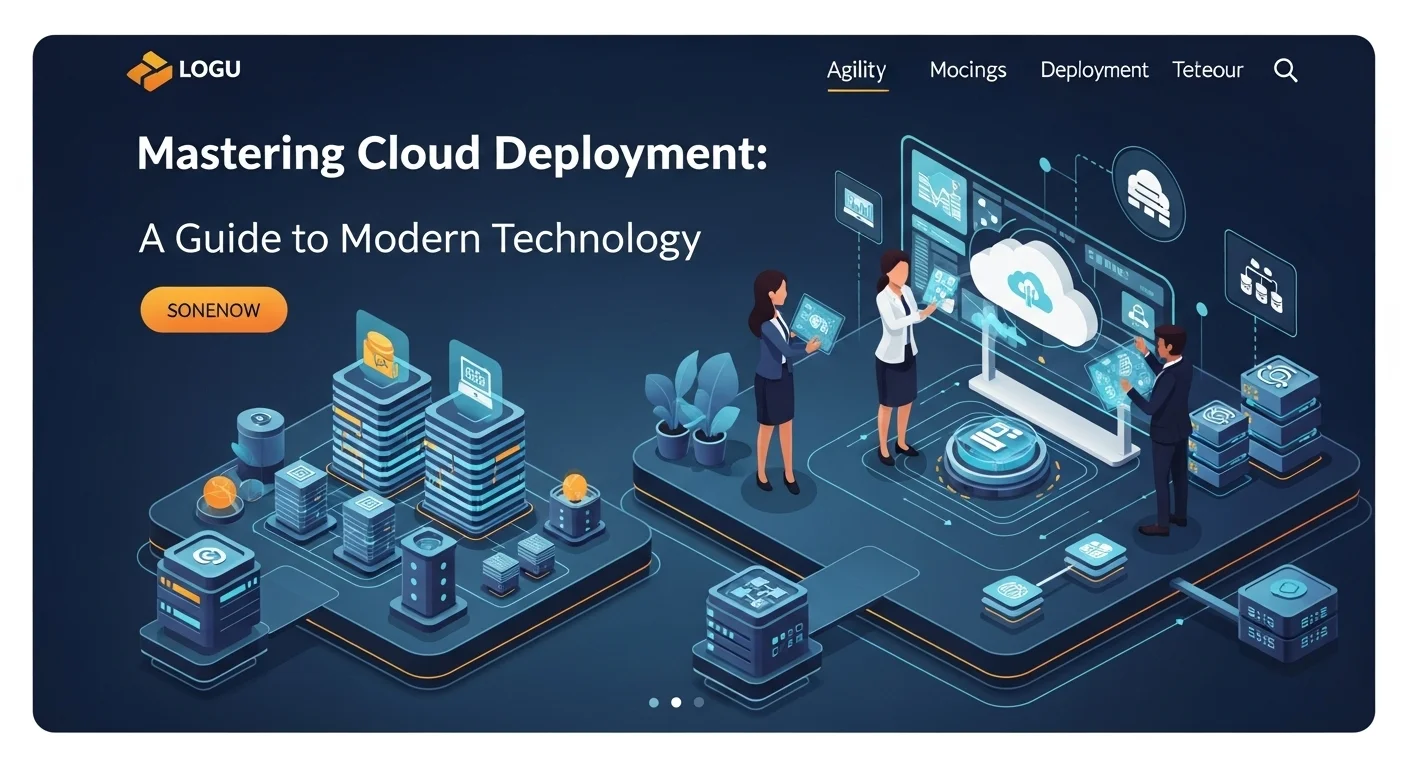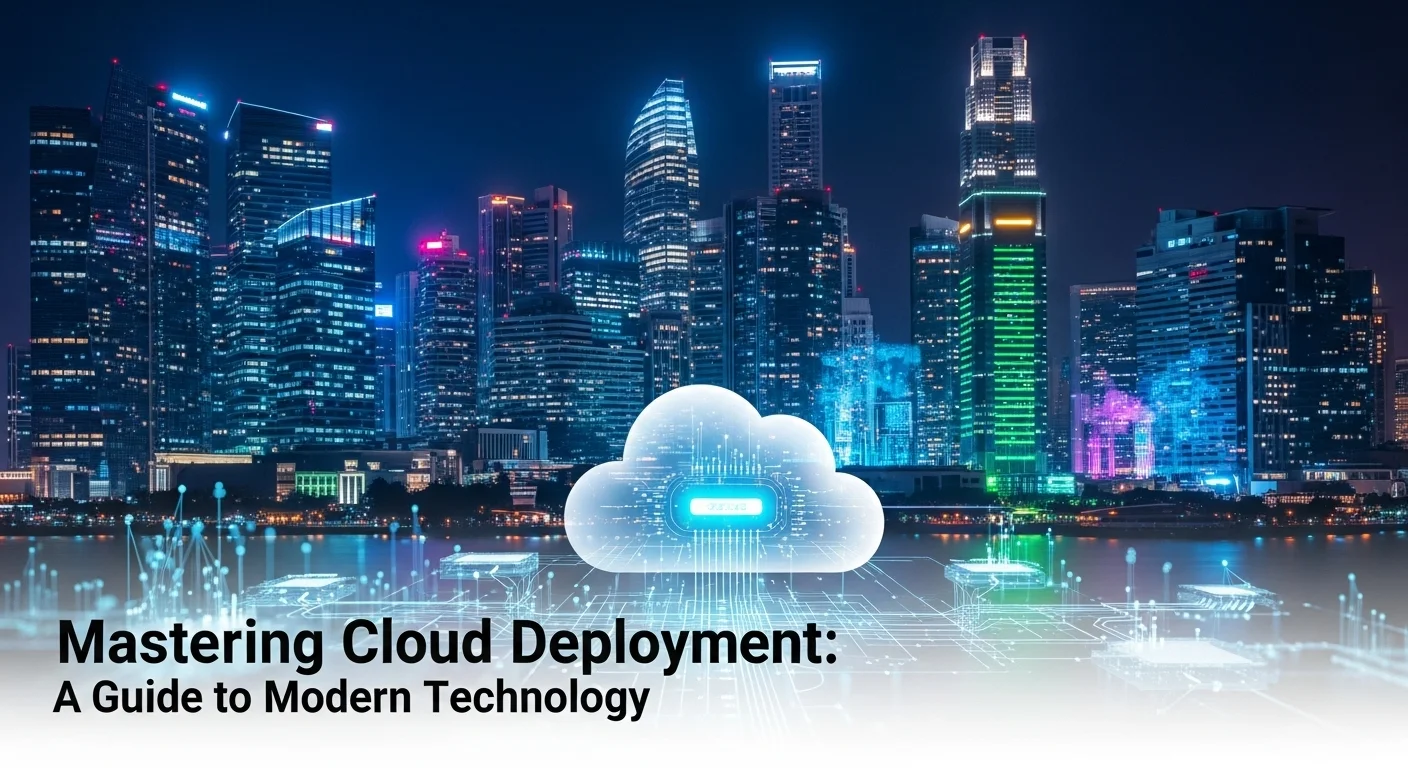Cloud Deployment Explained: My Practical Guide to Moving Your Tech Forward

Executive Summary
I remember the first time I moved a major application to the cloud. It was both exciting and daunting. The term 'Cloud Deployment' can sound complex, but at its heart, it's simply about how you get your software running in a cloud environment instead of on your own servers. In this guide, I'll walk you through everything I've learned over the years. We'll break down the core models like public, private, and hybrid clouds in plain English, so you can see which fits your needs. We'll also look at the big players—AWS, Azure, and GCP—and discuss how to choose the right platform. For anyone in tech, from business owners to developers, understanding how to use the cloud is key to staying competitive, scalable, and efficient. My goal is to give you a clear roadmap to harness the cloud's power, helping you drive innovation and transform how you work.
Table of Contents
- What is Cloud Deployment and Why Does It Matter?
- The Core Models of Cloud Deployment
- The Real-World Importance of Going Cloud
- How Businesses Actually Use the Cloud
What is Cloud Deployment and Why Does It Matter?
In today's digital world, you hear 'Cloud Deployment' everywhere. It’s a term that has completely changed the game for how businesses and developers manage their technology. At its core, cloud deployment is simply the process of running your applications and services on a cloud provider's infrastructure—think massive, powerful data centers owned by companies like Amazon or Google—instead of on servers in your own office. I’ve seen firsthand how this shift moves companies from a model where they spend huge amounts of money on buying and maintaining physical hardware to a more flexible, pay-as-you-go approach. Honestly, this transition is one of the biggest leaps in modern technology. It’s what fuels the digital transformation for everyone, from tiny startups to massive corporations. Knowing your way around cloud deployment isn't just a bonus skill anymore; it's essential for anyone in tech. The cloud gives you incredible scale, speed, and cost savings, allowing you to innovate faster and serve your customers better. It’s the engine behind everything from complex AI systems to the simple apps on your phone. The real magic is that it hides the messy complexity of managing physical servers, so your team can focus on what they do best: building great software. This is all possible through different service models like Infrastructure as a Service (IaaS), Platform as a Service (PaaS), and Software as a Service (SaaS), each offering a different level of control.
The Core Models of Cloud Deployment
To really get it, you need to understand the main ways cloud services are set up. Think of it like housing: you can rent an apartment, buy a house, or do a bit of both. Your choice affects your costs, security, and how much control you have. The three main models are public, private, and hybrid.
Public Cloud
The public cloud is the most common choice, like renting an apartment in a huge complex. Here, a provider like Amazon Web Services (AWS), Microsoft Azure, or Google Cloud Platform (GCP) owns and operates all the hardware. You access these resources over the internet and share the underlying infrastructure with other companies (this is called multi-tenancy). The biggest perks are massive scalability and a pay-as-you-go model, which means you don't have to buy your own expensive servers. It's perfect for businesses whose needs change often, as you can scale up for a big launch and then scale back down. A smart public cloud setup lets companies stop worrying about hardware and focus on growing their business.
Private Cloud
A private cloud, on the other hand, is like owning your own house. All the computing resources are dedicated to a single organization. This infrastructure can be in your own data center or hosted by a third party, but it's all yours. The main advantage is greater control and security, which is why it's a go-to for government agencies, banks, and anyone with strict data privacy rules. While it offers top-notch security, a private cloud usually costs more upfront and requires your own IT team to manage it. But for predictable workloads that need tight security, it's a solid, safe bet for running your software.
Hybrid Cloud Deployment
The hybrid model is becoming incredibly popular because it offers the best of both worlds. It’s like owning your house but also renting a flexible storage unit when you need extra space. This approach blends public and private clouds, letting you share data and apps between them. For instance, I've worked with companies that keep their super-sensitive customer data on their private cloud but run their public-facing website on the public cloud to handle traffic spikes. A well-planned hybrid strategy helps you optimize costs, boost security, and stay flexible. It allows you to tap into the massive scale of the public cloud while keeping your critical data safe and sound. It's a powerful approach, but it requires careful planning to make sure the two environments work together smoothly.
The Real-World Importance of Going Cloud
Moving to the cloud isn't just about changing where your servers live; it's a fundamental shift in how we build and deliver technology. Here's why it's such a big deal.
Scalability and Elasticity
One of the most amazing things about the cloud is scaling on demand. In the old days, if your website traffic surged, you had to buy, install, and set up new servers, which could take weeks. With the cloud, you can get more resources in minutes. This elasticity means your application can automatically grow to handle a rush of users and shrink back down when things quiet down, saving you money while keeping performance high.
Cost-Effectiveness
The cloud flips your spending from huge upfront capital expenses (CapEx) to predictable operational expenses (OpEx). Instead of buying a data center's worth of hardware, you pay a monthly fee based on what you use. This has been a game-changer for startups and small businesses, giving them access to the same powerful tech as huge corporations. Plus, you no longer have to pay for the power, cooling, and maintenance of physical hardware, which lowers your total costs.
Agility and Speed
In today's market, speed is everything. The cloud gives developers the tools to build, test, and launch applications faster than ever. Cloud platforms offer a massive menu of managed services—from databases to AI tools—that accelerate development. This speed allows teams to implement modern practices like CI/CD (Continuous Integration/Continuous Deployment) and get new features out to customers in record time.
Global Reach and Disaster Recovery
Major cloud providers have data centers all over the world. This lets you deploy your applications closer to your users, which reduces lag and improves their experience. This global network also makes disaster recovery much easier and more affordable. By copying your data and applications to different regions, you can stay online even if one location has a major outage. Building this kind of resilience used to be incredibly expensive, but the cloud makes it accessible to everyone.
How Businesses Actually Use the Cloud
Cloud deployment is being used in every industry to drive real results. For small businesses, it levels the playing field, offering access to powerful tech without a huge investment. They can launch new ideas quickly and scale as they succeed. For large companies, the cloud helps modernize old systems and create a culture of innovation. A hybrid approach, for example, helps them connect their existing on-premise systems with the flexible power of the public cloud. From streaming movies to running enterprise software, delivering modern digital services depends on the cloud. By using it, businesses can analyze massive datasets, build smart AI applications, and create amazing customer experiences. At the end of the day, a great cloud strategy isn't just about technology—it's about making your business more agile, resilient, and customer-focused.

A Complete Guide to Cloud Deployment in Your Business
Getting your cloud deployment right means understanding the 'how' just as much as the 'what' and 'why'. It's a journey that involves more than just lifting and shifting your apps; it requires a smart approach to your architecture, tools, and processes. Whether you're a developer on the front lines, an IT pro managing the systems, or a business leader making the big decisions, this guide will give you the knowledge to succeed. I've learned that the path to the cloud is a strategic one. Every step, from the initial migration to how you operate daily, needs to align with your business goals. This means picking the right way to migrate, choosing the best cloud platform for your needs, and adopting modern practices to manage it all effectively.
Technical Methods: Cloud Migration Strategies
For most organizations, the first step is moving existing applications to the cloud. There's no single right way to do this. I always refer to the '6 R's' of migration, a framework that helps you choose the best path based on your app, your business drivers, and your long-term vision.
Rehosting ('Lift and Shift')
This is the simplest approach: you move an application from your local servers to the cloud with very few changes. I've found this is often the quickest way to get started and is great for companies wanting to exit their own data centers fast. While it's speedy, 'lift and shift' doesn't really take advantage of cool cloud-native features like autoscaling. However, it can be a perfect first step, getting you into the cloud with a plan to optimize later.
Replatforming ('Lift and Reshape')
Replatforming is a middle ground. You make a few smart tweaks to your application during the move to take better advantage of the cloud. A common example I've implemented is moving a self-managed database to a managed cloud service like Amazon RDS. This offers a nice balance—you get noticeable performance and operational wins without having to completely rewrite your application.
Repurchasing ('Drop and Shop')
Sometimes, the best move is to switch to a different product entirely, usually a Software as a Service (SaaS) solution. Instead of migrating your old, custom-built CRM, you might switch to a provider like Salesforce. This lets you offload all the management of the app and its infrastructure to a vendor, freeing up your team to focus on what makes your business unique.
Refactoring / Rearchitecting
This is the most involved strategy, where you completely redesign the application to be cloud-native. It often means breaking a large, monolithic app into smaller 'microservices' and using advanced cloud tools like serverless functions. It's a big investment of time and resources, but in my experience, it delivers the biggest payoffs in scalability, resilience, and agility. This is the ultimate goal for truly maximizing the cloud's value.
Retaining and Retiring
Finally, remember that not every application belongs in the cloud. Some legacy systems might be too difficult or expensive to move, so you just keep them where they are (Retaining). Others might not even be necessary anymore and can be shut down for good (Retiring). A careful review of your application portfolio is crucial to focus your efforts where they'll have the most impact.
Leading Cloud Deployment Platforms: A Comparison
Choosing a cloud provider is a huge decision. The 'big three'—AWS, Microsoft Azure, and Google Cloud Platform (GCP)—dominate the market. Each is fantastic, but they have different strengths.
Amazon Web Services (AWS)
As the pioneer and market leader, AWS has the most extensive range of services and the largest global footprint. For deployment, I often turn to tools like AWS Elastic Beanstalk for web apps or Amazon EKS for managing containers. AWS is known for being incredibly mature and reliable, with a massive community. It's a solid choice for almost any workload, from startups to enterprises.
Microsoft Azure
Azure is a strong number two and a favorite in the enterprise world, especially for companies already using Microsoft products. Its big advantage is how well it integrates with on-premise systems like Windows Server and Office 365. For businesses deep in the Microsoft ecosystem, Azure often feels like the most natural path to a hybrid cloud setup, using tools like Azure Arc to bridge the gap.
Google Cloud Platform (GCP)
GCP shines when it comes to data analytics, machine learning, and containers. Google originally developed Kubernetes, the industry standard for container management, which gives them a real edge. I recommend GCP to organizations that are heavily data-driven and want to use cutting-edge AI and container technologies. Services like BigQuery and Google Kubernetes Engine (GKE) are best-in-class.
Modern Deployment Architectures and Techniques
A successful cloud strategy is about more than just being on the cloud; it's about using modern architectures and techniques to build better software.
Containers and Kubernetes
Containerization, with tools like Docker, has changed everything. A container packages your application and all its dependencies into a single, portable unit. This means it runs the same way everywhere, from a developer's laptop to production. Kubernetes is the tool that manages these containers at scale, automating deployment and scaling. It’s the backbone of most modern, microservices-based applications I build today.
Serverless Computing
Serverless computing takes abstraction even further. You simply write and deploy your code as individual functions, and you never have to think about servers. The cloud provider handles everything—provisioning, scaling, and managing the infrastructure. Services like AWS Lambda are perfect for event-driven tasks and can dramatically cut your operational costs and overhead.
CI/CD Pipelines
Continuous Integration and Continuous Deployment (CI/CD) is a set of automated practices for releasing software. A CI/CD pipeline automatically builds, tests, and deploys code changes, allowing teams to release updates faster and more reliably. Tools like Jenkins, GitLab CI, or the native DevOps services from the cloud providers are essential for any modern software team.
Deployment Strategies for High Availability
To release new versions without downtime or major risks, we use several smart strategies:
- Blue-Green Deployment: We run two identical production environments ('Blue' and 'Green'). The new version goes to the inactive 'Green' one. After testing, we flip the switch and send all traffic to Green. If anything goes wrong, we can instantly flip back.
- Canary Deployment: Here, we roll out the new version to a small group of users first. We monitor everything closely, and if it's stable, we gradually release it to everyone else. This limits the impact of any potential bugs.
- Rolling Deployment: This strategy slowly replaces old versions of the application with the new one, instance by instance. This ensures the application stays up and running throughout the update.
By combining the right migration plan, platform, architecture, and deployment techniques, you can build a cloud solution that is not just a technical project, but a strategic asset that drives real business value.

My Top Tips and Strategies for a Better Cloud Experience
Getting to the cloud is just the beginning. The real art lies in operating there effectively. To get the most out of your cloud investment, you need to adopt a mindset of continuous improvement. I've learned over the years that this comes down to a few key areas: security, cost management, performance, and governance. This section shares the practical tips and strategies I use to keep cloud environments running smoothly, securely, and cost-effectively. Whether you're managing a single website or a complex global system, these principles will help you avoid common pitfalls and build a solid foundation for the future.
1. Implement a Robust Security Posture
In the cloud, security is a partnership. The provider secures the cloud itself (the physical hardware), but you are responsible for securing what you put *in* the cloud (your data, apps, and access). Here’s my checklist for a strong security posture.
Identity and Access Management (IAM)
Always follow the principle of least privilege. This simply means people and services should only have the exact permissions they need to do their job, and nothing more. Enforce strong passwords and, wherever possible, use Multi-Factor Authentication (MFA). I make it a habit to regularly review IAM policies to clean up old permissions and keep everything tight.
Network Security
Use Virtual Private Clouds (VPCs) or Virtual Networks (VNets) to create your own isolated corner of the cloud. This is like putting a fence around your resources. Configure firewall rules to strictly control what traffic can get in and out. For anything sensitive, I always place it in a private subnet with no direct access from the internet. This is especially critical in a hybrid setup where your office network connects to the cloud.
Data Encryption
Protect your data everywhere. Encrypt it when it's being stored (at rest) and when it's moving across the network (in transit). All the major cloud platforms make this easy with managed encryption services. And always use HTTPS/TLS to protect data on the move. It's a non-negotiable for me.
Continuous Monitoring and Threat Detection
You can't protect against what you can't see. Use tools like AWS GuardDuty or Azure Sentinel to automatically scan for threats, vulnerabilities, and misconfigurations. These services can be lifesavers, sending you alerts on suspicious activity. Regular vulnerability scanning is also a must to find and fix weak spots before they can be exploited.
2. Master Cost Management and Optimization
I've seen it happen: the flexibility of the cloud's pay-as-you-go model can lead to shocking bills if you're not careful. A proactive approach to managing your cloud finances (often called FinOps) is essential.
Tagging and Cost Allocation
Implement a strict tagging strategy for everything you create in the cloud. Tags are simple labels that let you categorize resources by project, department, or team. Without them, figuring out who spent what is nearly impossible. Good tagging is the foundation of good cost management.
Budgets and Alerts
Set up budgets and alerts in your cloud provider's console. This is your early warning system. You'll get an email when costs are trending higher than expected, giving you time to investigate before the bill gets out of hand. Use the cost analysis tools to see where your money is going.
Right-Sizing and Reserved Instances
One of the most common ways people waste money is by over-provisioning resources. Continuously monitor your usage and 'right-size' your virtual machines to match actual demand. For steady, long-term workloads, I always recommend using pricing models like Reserved Instances or Savings Plans. You commit to using a certain amount of compute for 1-3 years and get a massive discount in return.
Automate Shutdown of Non-Production Resources
Your development and testing environments don't need to run 24/7. A simple script that shuts them down on nights and weekends can save you 30-40% on those resources. It's one of the easiest cost-saving wins.
3. Prioritize Performance and Reliability
A fast, reliable application keeps users happy. The cloud gives you all the tools you need to deliver a great experience.
Autoscaling and Load Balancing
Set up autoscaling to automatically adjust your capacity based on traffic. This ensures you can handle sudden spikes in demand without your app crashing, and it saves money by scaling down when it's quiet. A load balancer is also key, as it distributes traffic across multiple instances to prevent any single one from being overloaded and to improve fault tolerance.
Content Delivery Network (CDN)
Use a CDN like Amazon CloudFront or Google Cloud CDN. It caches your content in locations all around the world, closer to your users. This drastically reduces latency and makes your website or application feel much faster. For any modern web app, a CDN is a standard part of the architecture.
High Availability and Disaster Recovery
Design for failure. I build applications across multiple Availability Zones (which are separate data centers in the same region) to protect against a single data center outage. For mission-critical apps, we even plan for a multi-region strategy. And most importantly: test your disaster recovery plan regularly to make sure it actually works when you need it.
4. Leverage Automation and Infrastructure as Code (IaC)
Doing things manually is slow, error-prone, and doesn't scale. Automation is the secret to managing a cloud environment like a pro.
Infrastructure as Code (IaC)
Use IaC tools like Terraform or AWS CloudFormation to define your entire infrastructure in code. This means you can create, update, and replicate your environment with the click of a button. It prevents configuration mistakes and makes disaster recovery a breeze. In my opinion, IaC is a foundational practice for any serious cloud operation.
Configuration Management
Use tools like Ansible or Chef to automate the configuration of your servers. This ensures every system is set up in a consistent, predictable way, which simplifies management and improves security.
By embracing these strategies, you can move from just 'using' the cloud to truly mastering it. This process of continuous improvement is what allows businesses to build more resilient, secure, and cost-effective solutions. As a reference for building modern applications, I always recommend the Twelve-Factor App methodology; its principles are timeless. Adopting these tips will improve not just your tech, but your entire business's ability to thrive in the digital age.
Expert Reviews & Testimonials
Sarah Johnson, Business Owner ⭐⭐⭐⭐
As a small business owner, the section on cost management was a revelation. I'd love to see a follow-up with a case study of a company our size. Still, very insightful!
Mike Chen, IT Consultant ⭐⭐⭐⭐
This was a fantastic breakdown. The explanation of 'Replatforming' vs. 'Rehosting' finally clicked for me. It cleared up a lot of confusion I had. Great read.
Emma Davis, Tech Expert ⭐⭐⭐⭐⭐
Excellent and thorough guide to cloud deployment! As a tech pro, I appreciated the deep dive into deployment strategies like Blue-Green and Canary. It's a resource I'll be bookmarking and sharing with my team.



